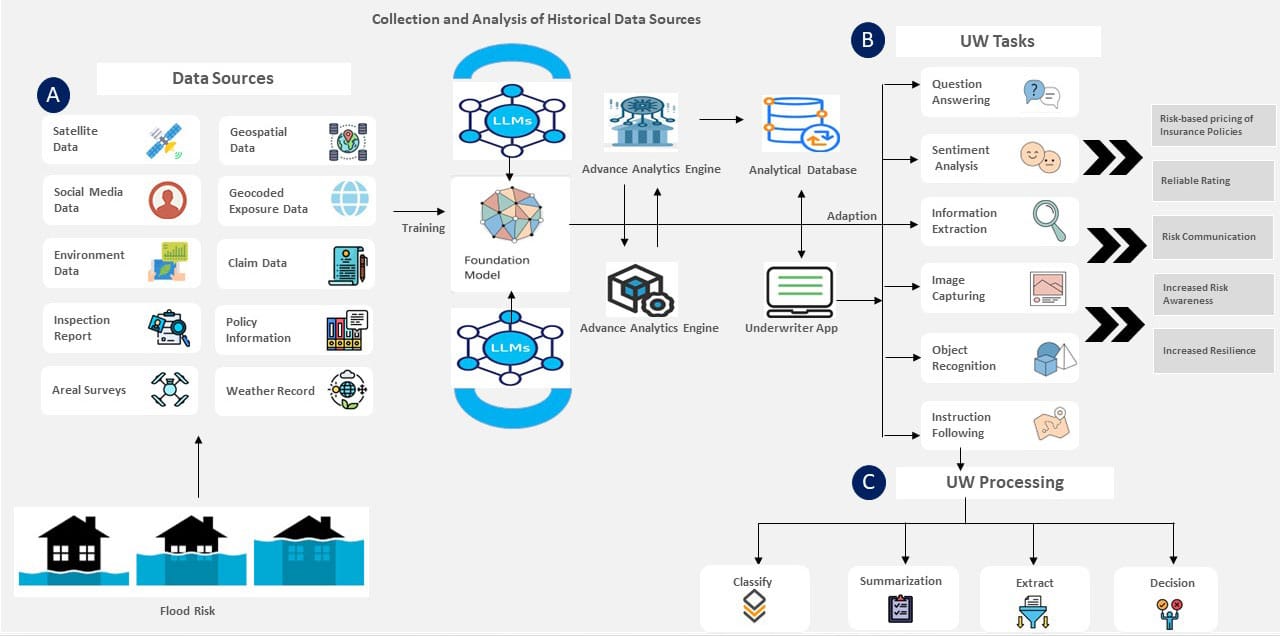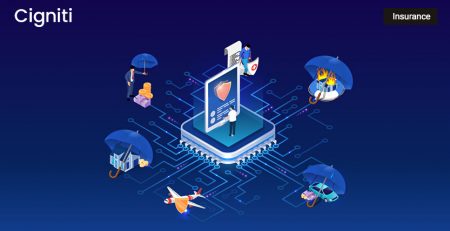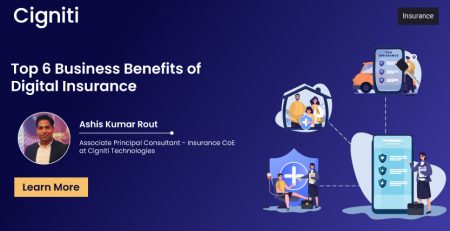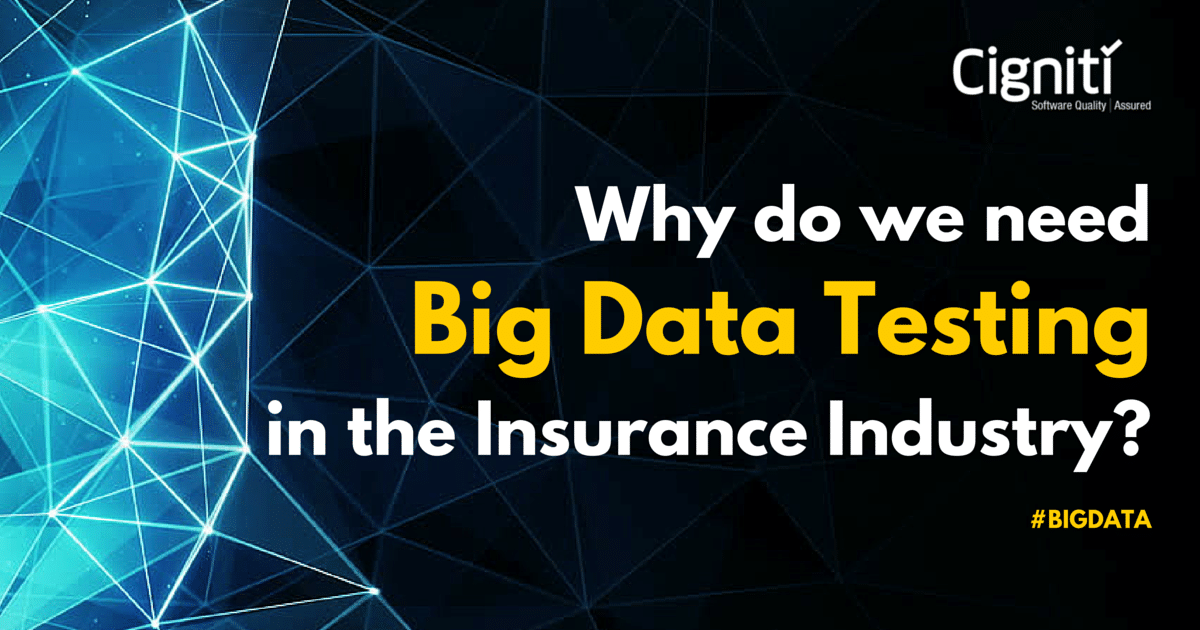Harnessing Generative AI for Flood Insurance Risk Evaluation and Mitigation
Floods are the most common natural disaster worldwide. A flood is demarcated as an overflow of water that submerges land that is usually dry. Flash flooding befalls when heavy rainfall over a short period hits areas with inadequate drainage. Other causes of flood events comprise high tides, storm surges, river overflow, and snow melt. Each year, floods extinguish assets worth billions of dollars. In the last five years alone, monetary losses caused by floods worldwide were estimated at 299 billion U.S. dollars. Insured losses accounted for about 15 percent of this total, at 44.5 billion dollars. Over the past 20 years, the report reveals that insurance in emerging markets has covered just 7% of aggregate monetary losses from flood events, compared with 31% in advanced economies.
Floods pose significant challenges to communities, infrastructure, and economies worldwide. With climate change exacerbating extreme weather events, the need for effective flood risk evaluation and mitigation has never been more urgent. This blog explores how Generative Artificial Intelligence (AI) is revolutionizing flood insurance risk assessment and mitigation strategies, offering innovative solutions to protect lives, property, and livelihoods. Data, risk modeling, and analytical tools are vital in improving and streamlining underwriting, pricing, policy administration, and claims processing.
Understanding Flood Coverage Insurance Risk
Flood coverage insurance risk assessment involves assessing factors like geographical position, demography, hydrological data, historical flood tide patterns, and structure vulnerability. Traditionally, this process has been complex and resource-ferocious, frequently counting on outdated models and limited data sources.
Enhancing Risk Assessment & Generative AI in Insurance
Insurers have relied on historical data and actuarial models to evaluate risks and set premiums accordingly. While these approaches have assisted the industry well, they have limitations when it comes to forecasting and considering complex, rapidly changing risks. Generative AI, conversely, presents a novel approach.
Generative AI utilizes pre-trained models that can discourse a wide array of circumstances, making it an invaluable tool for insurers. These models can be tailored to specific demographics, topographies, or perils, considering variables such as economic conditions, occupations, and projected lifespans. This position customization permits insurers to evaluate risks more precisely and adjust their coverage offerings accordingly.
Risk valuation, also identified as underwriting, is the methodology insurers utilize to estimate and evaluate the current and potential future risks connected with an insurance policy and its policyholder. This risk assessment helps determine the feasibility of coverage and subsequently adjusts the fluctuating cost of an insurance policy based on necessity. Figuring out the ideal premium to charge isn’t a straight line, and there is still a lot of uncertainty that keeps individuals from getting the most cost-effective and best coverage possible.
Generative AI, a subset of artificial intelligence engrossed in creating new content, images, or data that mimic real-world phenomena, has seemed like a game-changer in flood risk evaluation and mitigation. By leveraging advanced algorithms and machine learning techniques, Generative AI empowers insurers, governments, and stakeholders to evaluate vast amounts of data, simulate flood scripts, and develop proactive mitigation strategies.
Key Benefits of Generative AI in Insurance and Flood Risk Management

Flood Risk Assessment and Underwriting Model through Generative AI
Enhanced Risk Assessment: Generative AI processes large datasets from diverse sources, including satellite imagery, weather forecasts, historical flood data, weather records, and environmental data, to generate actionable insights and identify high-risk areas. Generative AI algorithms can analyze vast amounts of data from diverse sources to provide more accurate risk assessments. This leads to better-informed decision-making by insurance companies and policyholders. Also, this enables insurers to understand better and quantify flood risks associated with specific locations.
Improved Underwriting Accuracy: Generative AI leverages advanced analytics to help insurance companies make more informed underwriting decisions. Insurers can tailor coverage options and pricing based on individual properties’ precise flood risk profiles, resulting in more accurate and fair premiums.
Advanced Predictive Modeling: Generative AI algorithms can evaluate vast amounts of historical flood data, weather patterns, terrain information, and other relevant factors to develop highly accurate predictive models. These models can forecast flood events with greater precision, allowing insurers to proactively plan. They also help determine the feasibility of coverage and subsequently adjust the fluctuating cost of an insurance policy based on necessity.
Timely Claims Processing: Generative AI can expedite claims processing by automating data analysis and assessment tasks. This reduces the time it takes for insurers to evaluate flood damage, verify claims, and disburse payments to policyholders, leading to faster claim resolutions and improved customer satisfaction.
Faster Processing: Generative AI automates the analysis process, reducing the time required for risk evaluation and mitigation. This enables insurance companies to respond more quickly to changing flood scenarios and provide timely coverage to policyholders.
Enhanced Fraud Detection: Generative AI algorithms can identify patterns and anomalies in flood insurance claims data that may indicate fraudulent activity. By flagging suspicious claims for further investigation, insurers can mitigate fraud-related losses and protect their bottom line.
Customized Policy Recommendations: Generative AI can generate personalized policy recommendations for policyholders by analyzing individual property characteristics and flood risk factors. Insurers can offer tailored coverage options and risk management strategies that meet each customer’s unique needs and preferences.
Cost-Effectiveness: Generative AI helps insurance companies optimize resources and minimize operational costs by streamlining the risk assessment process and reducing manual intervention. This ultimately translates to more affordable premiums for policyholders.
Conclusion
Generative AI represents a paradigm shift in flood risk management, offering unprecedented capabilities to evaluate, predict, and mitigate flood hazards. By harnessing the power of Generative AI, stakeholders can make more informed decisions, build resilient communities, and safeguard lives and property against the growing threat of floods. This dynamic synergy empowers insurers to make informed decisions while policyholders benefit from more accurate coverage that aligns with the unique risks associated with their properties. As this technological integration advances, the insurance industry is poised to enhance resilience and responsiveness in the face of hurricane threats, ultimately creating a safer and more secure future for at-risk communities.
Cigniti has end-to-end generative AI solutions that guarantee insurance companies’ business participation in the AI landscape. Cigniti has extensive experience assisting in generative AI solutions (including testing) while considering the needs of insurance companies and helping them gain a competitive advantage. Cigniti’s testing and digital services portfolio and unparalleled track record have proved it a preferred technology partner for insurance clients.
Need help? Talk to our insurance domain experts to learn more about the opportunities the generative AI solution brings to the insurance value chain.





Leave a Reply